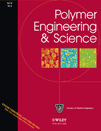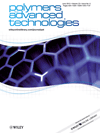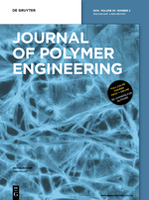
POLYMER ENGINEERING AND SCIENCE
Scope & Guideline
Transforming Ideas into Polymer Solutions
Introduction
Aims and Scopes
- Polymer Synthesis and Processing:
Research on various synthesis techniques for polymers including conventional and novel methods such as electrospinning, 3D printing, and reactive extrusion, with an emphasis on optimizing processing parameters. - Characterization Techniques:
Studies involving advanced characterization methods to analyze the physical, chemical, and mechanical properties of polymers at different scales and conditions. - Biodegradable and Sustainable Polymers:
Exploration of environmentally friendly polymers, biodegradable materials, and recycling technologies aimed at reducing environmental impact and promoting sustainability. - Nanocomposites and Hybrid Materials:
Investigation into the incorporation of nanoparticles and other fillers to enhance the mechanical, thermal, and electrical properties of polymer matrices. - Polymer Applications in Engineering:
Application-oriented research focusing on the use of polymers in various engineering fields, including automotive, aerospace, biomedical, and packaging industries. - Smart and Responsive Polymers:
Development of smart polymers with functionalities such as self-healing, shape memory, and stimuli-responsiveness for advanced applications. - Tribology and Surface Interactions:
Research addressing the tribological behavior of polymers and their interactions with other materials, including coatings and composites.
Trending and Emerging
- Sustainable and Biodegradable Materials:
There is a growing focus on developing biodegradable polymers and sustainable materials, driven by environmental concerns and the need for eco-friendly solutions in various applications. - Smart Polymers and Responsive Materials:
Research on smart polymers that can respond to external stimuli (e.g., temperature, pH, light) is on the rise, highlighting innovations in applications such as drug delivery systems and self-healing materials. - Nanocomposite Development:
The integration of nanomaterials into polymer matrices to enhance properties is trending, with significant research dedicated to understanding the interactions and resulting material behaviors. - Advanced Characterization Techniques:
Emerging methodologies for the characterization of polymers are increasingly featured, including in situ and real-time monitoring techniques that provide deeper insights into polymer behavior during processing. - Multifunctional Polymer Systems:
Research focusing on multifunctional polymers that combine multiple properties (e.g., mechanical strength, electrical conductivity, thermal stability) is gaining traction, especially for advanced engineering applications. - Circular Economy in Polymer Science:
The integration of recycling technologies and circular economy principles in polymer development is increasingly relevant, reflecting a shift towards sustainable practices in the industry.
Declining or Waning
- Traditional Polymer Blends:
There has been a noticeable decrease in studies focused solely on conventional polymer blends, as researchers increasingly explore more complex systems involving nanocomposites and hybrid materials. - Conventional Mechanical Properties Testing:
Research specifically dedicated to basic mechanical property testing of polymers without advanced characterization or novel applications appears to be waning, as the field moves towards more comprehensive and multifaceted analyses. - Focus on Non-Biodegradable Materials:
The trend towards sustainability has led to a reduction in research on non-biodegradable polymers, as the academic community increasingly prioritizes environmentally friendly alternatives. - Simple Additive Manufacturing Techniques:
Interest in basic or traditional additive manufacturing methods is declining as more complex and innovative techniques gain traction, reflecting a shift towards enhancing performance through advanced methodologies.
Similar Journals

JOURNAL OF POLYMER SCIENCE
Elevating Polymer Science: Bridging Research and Real-World ApplicationsJOURNAL OF POLYMER SCIENCE, published by WILEY, is a premier, open-access journal dedicated to advancing the field of polymer science and its applications. With an ISSN of 2642-4150, it offers a platform for high-quality research and innovative ideas, contributing significantly to the understanding of polymaterials and their functionalities. The journal is recognized for its exceptional impact within various categories, consistently achieving Q1 rankings in Materials Chemistry, Physical and Theoretical Chemistry, and Polymers and Plastics, demonstrating its influential presence in the academic community. As of 2023, it holds a distinguished position in Scopus rankings, underscoring its relevance and rigorous peer-review process. By facilitating open access to vital research findings, the JOURNAL OF POLYMER SCIENCE plays a crucial role in fostering collaboration and knowledge transfer among researchers, professionals, and students, paving the way for innovative developments in polymer applications and materials science.

POLYMERS FOR ADVANCED TECHNOLOGIES
Exploring the Frontiers of Polymer ApplicationsPOLYMERS FOR ADVANCED TECHNOLOGIES is a premier peer-reviewed journal published by WILEY, focusing on cutting-edge research in the field of polymers and plastics. Since its inception in 1990, the journal has established itself as a critical resource for academics and industry professionals alike, reflecting advancements and innovations in polymer science and technology. With an impressive Scopus ranking of #45 out of 161 in the Materials Science category and a 72nd percentile ranking, it ranks in the Q2 quartile for its relevance and impact within the polymers field. The journal's comprehensive scope encompasses recent developments and trends in polymer applications, synthesis, and characterization, making it essential reading for researchers looking to advance their work within this dynamic area. Researchers can submit their work in the UK, where the journal is published, and while it does not currently offer open-access options, its robust impact factor highlights the significance of the research it disseminates. Join the community of experts pushing the boundaries of polymer science by engaging with POLYMERS FOR ADVANCED TECHNOLOGIES. Continuous exploration and innovation await those who contribute to and learn from the journal’s diverse array of studies.

E-POLYMERS
Transforming Ideas into Solutions in Polymer ScienceE-Polymers, an esteemed journal published by De Gruyter Poland Sp. z o.o., serves as a vital platform for advancing knowledge in the fields of chemical engineering, polymer science, and theoretical chemistry. With its Open Access policy since 2019, researchers from around the globe can freely access and disseminate groundbreaking findings that span the convergence of diverse disciplines, making it an indispensable resource for both academia and industry. The journal is recognized for its significant impact, reflected in its Q2 ranking in Chemical Engineering, Physical and Theoretical Chemistry, and Polymers and Plastics categories in 2023. Its impressive Scopus rankings further solidify its position, showcasing a percentile rank of 70th and above across major categories. With a publication history extending from 2001 to 2024, E-Polymers continually addresses pressing challenges within the polymer research community, fostering innovation and collaboration among researchers, professionals, and students eager to contribute to the evolving landscape of materials science.

POLYMER INTERNATIONAL
Driving Excellence in Polymer ResearchPOLYMER INTERNATIONAL is a leading journal in the field of polymer science, published by Wiley, one of the most esteemed scholarly publishers. With an ISSN of 0959-8103 and an E-ISSN of 1097-0126, this journal has been a pivotal platform for researchers since its inception in 1991, now extending its coverage until 2024. The journal boasts a commendable standing in various scientific domains, achieving a Q2 quartile ranking in Materials Chemistry, Organic Chemistry, and Polymers and Plastics as of 2023. Additionally, it holds impressive Scopus ranks, including Rank #47 in Organic Chemistry and Rank #40 in Polymers and Plastics, placing it within the top percentiles of its categories. Researchers, professionals, and students alike can benefit from its rich array of articles that contribute to the understanding and advancement of polymer technology and materials science. Although not an open access journal, POLYMER INTERNATIONAL remains crucial for disseminating high-quality research that drives innovation and development within the field.

INTERNATIONAL JOURNAL OF POLYMER ANALYSIS AND CHARACTERIZATION
Pioneering research in analytical chemistry and polymers.International Journal of Polymer Analysis and Characterization is a distinguished scholarly publication dedicated to the field of polymer science, with a focus on innovative methodologies and significant advances in the analysis and characterization of polymeric materials. Published by Taylor & Francis Ltd in the United Kingdom, this journal serves as a vital resource for researchers, professionals, and students deeply engaged in Analytical Chemistry, Chemical Engineering, and Polymer Science. With a convergence spanning from 1995 to 2024, it holds a Q3 ranking in the 2023 category quartiles for its valuable contributions to the fields of Analytical Chemistry, Chemical Engineering, and Polymers and Plastics. Despite being a non-open access publication, its rigorous peer-review process and comprehensive coverage of current trends ensure that the journal remains a crucial platform for disseminating impactful research. The journal is indexed in various databases, underscoring its relevance and quality in the academic community. Exploratory studies and articles that push the boundaries of polymer analysis find a welcoming home within these pages, making it an essential read for those aiming to stay at the forefront of polymer research.

MACROMOLECULAR RESEARCH
Empowering the Future of Macromolecular InnovationMACROMOLECULAR RESEARCH, published by the POLYMER SOC KOREA, is a premier journal dedicated to advancing the field of macromolecular science and polymer engineering. With its ISSN 1598-5032 and E-ISSN 2092-7673, this journal has emerged as a vital platform for researchers and professionals interested in the application and development of polymers across various domains. Based in South Korea and operating as an open-access resource since its inception in 2002, MACROMOLECULAR RESEARCH consistently ranks in the Q2 category across diverse fields such as Chemical Engineering, Materials Chemistry, and Organic Chemistry as per the latest 2023 metrics. Notably, it is recognized for its substantial contributions to polymery science, increasing its visibility and impact in global research. By providing a forum for original research articles, reviews, and innovative methodologies, this journal aims to foster collaboration and knowledge sharing among scientists, engineers, and students alike. Join a community that is at the forefront of polymer research by exploring the wealth of resources and cutting-edge studies featured in MACROMOLECULAR RESEARCH.

Polymers
Empowering scientists to shape the future of materials.Polymers is a premier journal published by MDPI, dedicated to advancing the field of polymer science and technology. This open-access journal, established in 2009, has quickly gained prominence in the academic community, serving as a vital platform for disseminating high-quality research articles, reviews, and communications in the realms of chemistry, polymers, and plastics. Based in Switzerland, with an impressive ranking in the Q1 quartile for both Chemistry and Polymer studies, Polymers boasts a significant impact factor, reflecting its rigorous peer-review process and esteemed editorial board. Researchers, professionals, and students alike benefit from the broad accessibility of content, allowing for a more extensive reach and engagement within the scientific community. As a key resource for the latest advancements and innovations in polymer research, Polymers continues to lead discussions, inspire collaborations, and foster the development of novel materials that shape various industrial applications.

Journal of Polymer & Composites
Pioneering Research at the Intersection of Polymers and Composites.Journal of Polymer & Composites, with ISSN 2321-8525 and E-ISSN 2321-2810, is an esteemed academic journal published by STM JOURNALS, dedicated to the advancement of knowledge in the rapidly evolving fields of polymer science and composite materials. The journal serves as a pivotal platform for researchers and professionals, offering cutting-edge research articles, reviews, and case studies that explore innovative developments and applications in polymer chemistry, material science, and engineering. Although currently lacking an impact factor citation, the journal aims to foster dialogue among academia and industry partners, addressing the latest trends and breakthroughs that drive the field forward. With a commitment to scholarly excellence, the Journal of Polymer & Composites is positioned as an essential resource for enhancing the understanding of polymer composites and their multifaceted applications. Notably, STM JOURNALS' reputation for quality publications underscores the journal’s importance in facilitating impactful research and educational initiatives worldwide.

POLYMER SCIENCE SERIES A
Shaping Tomorrow's Innovations in PolymersPOLYMER SCIENCE SERIES A is a distinguished journal dedicated to the field of polymer science, with a focus on advancing knowledge in materials chemistry and polymers and plastics. Published by MAIK NAUKA/INTERPERIODICA/SPRINGER, this journal provides a platform for researchers and practitioners to disseminate their findings and innovations. With an ISSN of 0965-545X and an E-ISSN of 1555-6107, it is widely accessible to the academic community. Although currently non-open access, the journal has maintained its significance since its inception in 1991, boasting an evolving emphasis on contemporary issues in polymer science up to 2024. Ranked in the Q3 category for both Materials Chemistry and Polymers and Plastics in 2023, POLYMER SCIENCE SERIES A plays a crucial role in the broader academic landscape, particularly for those committed to understanding and enhancing polymer materials. The journal’s reputation is solidified by its Scopus rankings, where it addresses critical advancements and fosters collaborative research opportunities within the community. We invite researchers, professionals, and students to explore the valuable insights published within these pages.

JOURNAL OF POLYMER ENGINEERING
Advancing the Frontiers of Polymer Science.JOURNAL OF POLYMER ENGINEERING, published by Walter de Gruyter GmbH, stands as a pivotal platform in the field of polymer science and engineering. With an ISSN of 0334-6447 and an E-ISSN of 2191-0340, this journal has been a vital contributor to the academic landscape since its inception, spanning publications from 1981 to 2024. As a recognized entity in the realms of Chemical Engineering, Materials Chemistry, and Polymers and Plastics, it holds a respectable position in Q3 quartile rankings according to the latest assessments. The journal is positioned to promote the exchange of cutting-edge research findings, technological advancements, and critical reviews that address the complexities of polymer application and innovation. Researchers and professionals will find a wealth of information, from experimental methodologies to theoretical analyses, all designed to inspire and elevate the current understanding of polymer engineering. By fostering collaboration and dissemination of knowledge, the JOURNAL OF POLYMER ENGINEERING remains crucial for advancing research and education in its specialized domains.